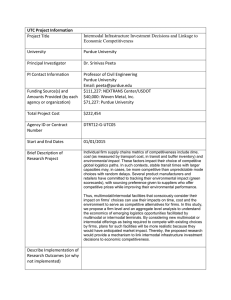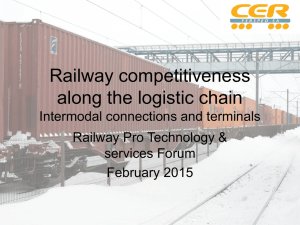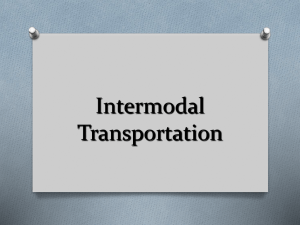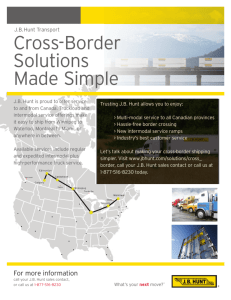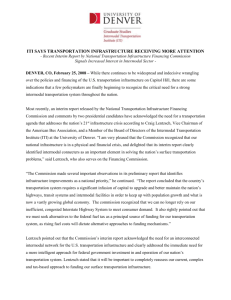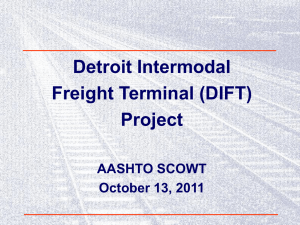INTERMODAL TRANSPORTATION:
advertisement
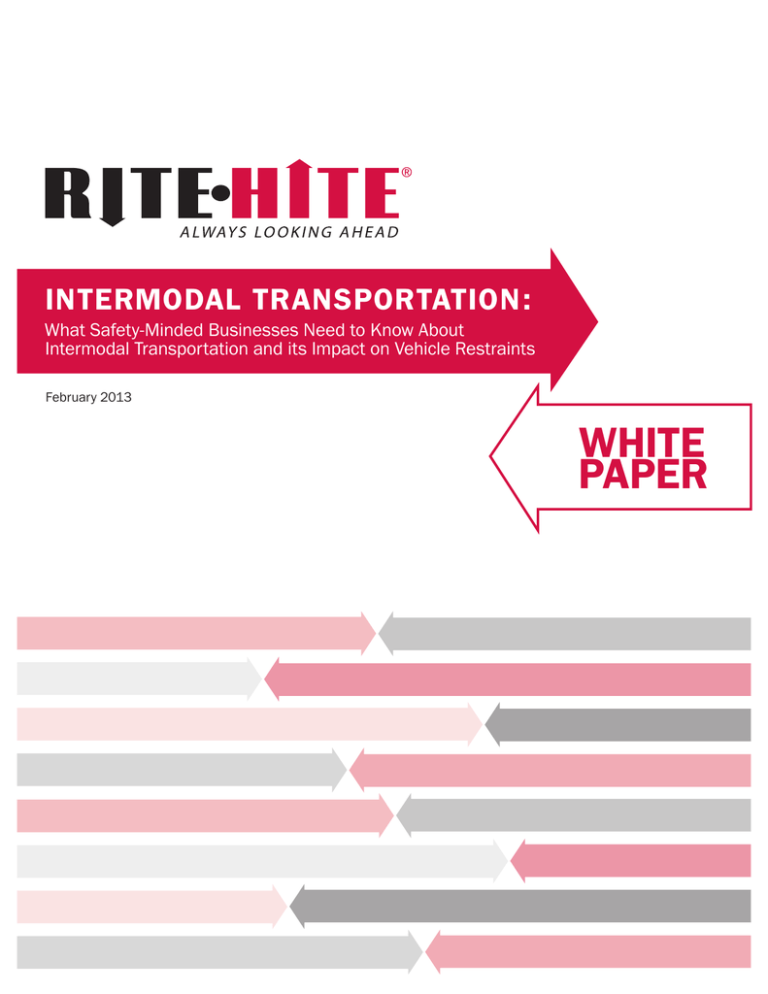
INTERMODAL TRANSPORTATION: What Safety-Minded Businesses Need to Know About Intermodal Transportation and its Impact on Vehicle Restraints February 2013 WHITE PAPER 1 THE GROWTH OF INTERMODAL TRANSPORTATION Intermodal transportation has roots dating back to the 18th century. During that time, mining companies in England would ship coal containers up and down canals to horsedrawn vehicles waiting on shore.1 This trend of transporting cargo using multiple modes of shipping (without the actual handling of freight) may have originated hundreds of years ago, but has gained serious momentum in recent years. The expanded use of trailer-sized containers to move goods around the world has transformed the way freight is packed and loaded on trucks, ships and railcars. Today, intermodal transportation is experiencing rapid growth, fueled by a global economy and the need to transport goods over greater distances using a variety of transportation vehicles. In addition, rising fuel costs, highway congestion and increased trucking legislation have led many companies to look at moving freight via railcar or cargo ship. These forms of transportation can handle much larger loads and are often more cost effective and efficient at moving freight. Recent studies support the growing intermodal trend. According to BSR.org, the intermodal industry transports more than one-third the value of global trade and provides more than 4.2 million jobs worldwide.2 In the United States alone, domestic container traffic increased nearly 10 percent from 2010 to 2011 according to the Intermodal Association of North America.3 The U.S. Department of Transportation projects that international container traffic will more than double by 2020.4 There is no dispute that intermodal transportation is on the rise and shows no signs of slowing down. Many experts feel the expansion of the Panama Canal, which is scheduled for completion in 2014, will only fuel the trend. The expanded canal will allow passage to ships with nearly three times the container capacity, doubling the canal’s throughput once the project is completed.5 INTERMODAL TRANSPORTATION AND THE LOADING DOCK The rapid growth and expansion of intermodal transportation impacts a wide variety of businesses and industries worldwide. By its very nature, intermodal transportation requires collaboration among two or more forms of transportation, meaning businesses are increasingly partnering to bring goods to market. For example, the “ship-rail-trailer” method of intermodal transportation places a container on a cargo ship that ports in a U.S. city. The container is then unloaded to a railcar, which transports the container to a regional hub where it is loaded on a tractor trailer. This process requires multiple businesses working together and has expanded shipping beyond traditional port towns. This increases the likelihood that intermodal containers will end up at your loading dock. Many intermodal containers have a cover plate above the rear impact guard that can interfere with the chassis being safely secured to the loading dock. An unsecure trailer can pose a number of risks for companies, including worker injuries or fatalities, damaged equipment and goods, lost productivity and more. Wikipedia, Intermodal Freight Transportation, http://en.wikipedia.org/wiki/Intermodal_freight_transport BSR.org, Sustainability Trends in the Container Shipping Industry, http://www.bsr.org/reports/BSR_Sustainability_Trends%20_Container_Shipping_Industry_September_2010.pdf 3 Intermodal.org, Intermodal Industry Stats 2011, http://www.intermodal.org/statistics_files/stats6.shtml 4 American Association of Port Authorities, U.S. Public Port Facts, July 2008, http://www.aapa-ports.org/files/pdfs/facts.pdf 5 Rodolfo R. Sabonge, “Panama Canal Expansion: Changing Dynamics of World Trade,” AAPA Seaports Magazine, Summer 2008 6 United States Department of Labor, Occupational Safety and Health Administration (OSHA), Worker Safety Series – Warehousing, http://www.osha.gov/Publications/warehousing.html 1 2 2 UNIVERSAL VEHICLE RESTRAINTS Intermodal container with cover plate. According to OSHA, approximately 100 employees are killed and 95,000 injured every year while operating forklifts. Forklift accidents that happen at the loading dock can be reduced or eliminated by properly restraining a trailer or container. Some of the more common accidents include: • Early Departure – A truck driver unexpectedly drives away from the loading dock while a forklift operator is entering, leaving or still inside the trailer. • Landing Gear Collapse – The landing gear on a trailer gives way causing the trailer to pitch forward or fall to the side. • Trailer Pop-Up – A loaded forklift entering the rear of the trailer causes it to move forward and drop, causing the nose of the trailer to suddenly rise. • Trailer Upending – The weight of the forklift sends the trailer’s nose down, causing the rear end to move up and away from the building. • Trailer Creep – Repeated impact from the lift truck causes the trailer to edge away from the dock, which can result in the lift truck falling to the ground. To help reduce the risk of accidents, many companies are investing in automatic vehicle restraint systems to secure trailers at the loading dock and keep workers out of the drive approach. But what about intermodal containers? It is important for safety-minded companies to research their options and select a system that meets today’s changing environment. Rite-Hite Dok-Loks® offer the widest wrap around coverage on a trailer’s rear-impact guard. Rite-Hite is an example of a company that is developing universal vehicle restraints designed for both trailers and intermodal containers. The company – which invented the vehicle restraint industry in 1980 – continues to develop new products to meet industry demands. Rite-Hite recently introduced the Dok-Lok® RHR-4000, which has a unique hook design that helps protect against all types of trailer separation accidents, accommodating traditional rear-impact guards and intermodal containers. In addition to having the most substantial wrap on rear-impact guards, the Dok-Lok RHR-4000 is the only product to incorporate the patented shadow hook, which adds another layer of safety by securing intermodal containers with rear-impact guard obstructions. When the Dok-Lok is activated, the hook attempts to wrap around the rear-impact guard. If the hook comes in contact with a plate obstruction, the shadow hook pivots to secure the trailer in place. If the trailer moves, the shadow hook locks in the safety stop, which prevents trailer separation accidents. ...MANY COMPANIES ARE INVESTING IN AUTOMATIC VEHICLE RESTRAINT SYSTEMS TO SECURE TRAILERS AT THE LOADING DOCK AND KEEP WORKERS OUT OF THE DRIVE APPROACH. BUT WHAT ABOUT INTERMODAL CONTAINERS? Rite-Hite Dok-Lok RHR-4000 shadow hook makes contact with the cover plate and pivots to secure the intermodal container. 3 VISUAL COMMUNICATION SYSTEMS Installing a vehicle-restraint system is the first step to improving loading dock safety. However, clear communication is just as critical to accident prevention as the restraint. It is important to choose a system that offers full-time communication of the restraint status to the truck driver, dock personnel and forklift operator. A full-time visual communication system is the most effective way to communicate restraint status and whether it is safe to enter/exit the trailer. Traditional vehicle restraint systems use a red or green light on the control box to indicate restraint status. This is an important safety feature, but it has limitations. For example, what if the control box is not in the line of sight of the forklift operator? What if the forklift load is obstructing the control box? What if the control box is covered by pallets? Fully-integrated communication systems that provide instant, status-at-a-glance feedback provide the safest solution. For example, Rite-Hite offers the Rite-Vu™ Light Communication System, which provides clear, constant communication of restraint status to the forklift operator when entering and exiting the trailer. In addition to lights on the control box, the system features Corner-Vu lights that are located in the upper corners of the interior dock door. These lights provide a highly-visible status report as the forklift driver enters the trailer. There is also Leveler-Vu lights that are mounted on the dock leveler to confirm restraint status as the forklift driver exits the trailer. The Rite-Vu system comes standard with the Dok-Lok® RHR-4000. All vehicle restraint systems vary by manufacturer, so it is important to meet with a representative who can best assess your needs. Companies like Rite-Hite provide onsite demonstrations, perform safety assessments and can develop customized solutions for the unique demands of a loading dock environment. SUMMARY As intermodal transportation continues its global expansion, it is important for safety-minded companies to stay ahead of the curve when it comes to their business processes, which includes choosing the right vehicle restraint systems. Global transportation trends indicate that loading docks will increasingly see more intermodal containers. Universal vehicle restraint systems, like the Dok-Lok RHR-4000, are necessary to provide the highest level of safety at the loading dock due to their ability to secure traditional trailers as well as intermodal containers. To learn more about vehicle restraints, receive a loading dock assessment or to schedule a demonstration, visit RiteHite.com and click on the “Vehicle Restraint” box. You can also schedule an appointment by calling (800) 456-0600. Above: Rite-Vu lights mounted on dock leveler Below: Rite-Vu lights mounted on the corners of the interior dock door.
